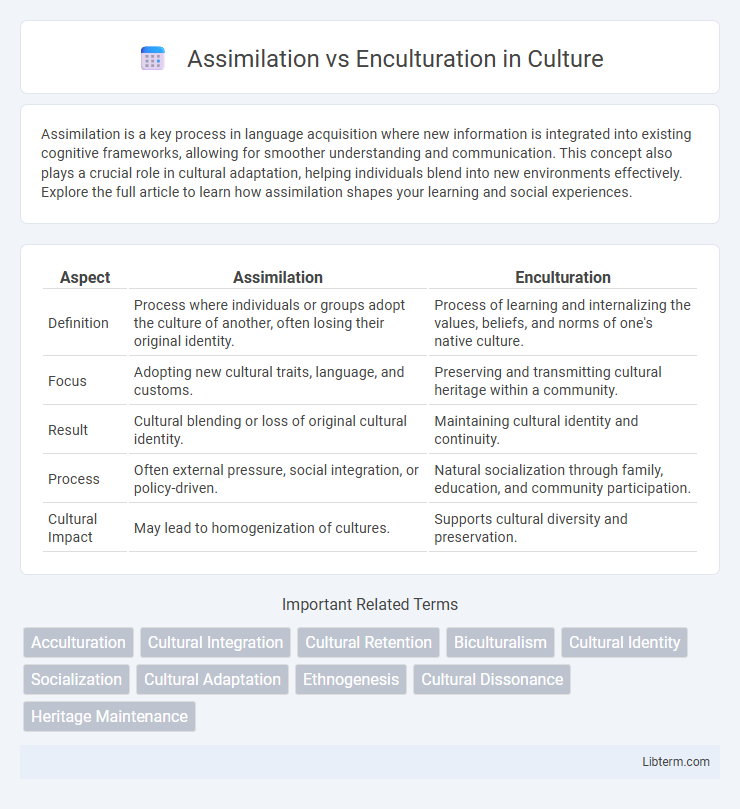Assimilation is a key process in language acquisition where new information is integrated into existing cognitive frameworks, allowing for smoother understanding and communication. This concept also plays a crucial role in cultural adaptation, helping individuals blend into new environments effectively. Explore the full article to learn how assimilation shapes your learning and social experiences.
Table of Comparison
| Aspect | Assimilation | Enculturation |
|---|---|---|
| Definition | Process where individuals or groups adopt the culture of another, often losing their original identity. | Process of learning and internalizing the values, beliefs, and norms of one's native culture. |
| Focus | Adopting new cultural traits, language, and customs. | Preserving and transmitting cultural heritage within a community. |
| Result | Cultural blending or loss of original cultural identity. | Maintaining cultural identity and continuity. |
| Process | Often external pressure, social integration, or policy-driven. | Natural socialization through family, education, and community participation. |
| Cultural Impact | May lead to homogenization of cultures. | Supports cultural diversity and preservation. |
Understanding Assimilation: Definition and Key Concepts
Assimilation is the process by which individuals or groups adopt the cultural traits of another group, often losing their original identity to conform to the dominant culture. Key concepts include acculturation, where cultural modification occurs through contact, and integration, signifying complete absorption into the host society. This contrasts with enculturation, which involves learning and maintaining one's native culture from birth.
What is Enculturation? A Comprehensive Overview
Enculturation is the process through which individuals learn and adopt the cultural norms, values, behaviors, and social practices of their community from birth, primarily through family, education, and social interactions. This cultural transmission shapes identity and social cohesion by embedding language, rituals, and worldviews intrinsic to a specific society. Enculturation contrasts with assimilation by maintaining cultural distinctiveness while integrating individuals into their native cultural environment.
Historical Contexts of Assimilation and Enculturation
Historical contexts of assimilation include the forced integration policies imposed on Indigenous peoples in North America and Australia, where dominant cultures sought to erase native languages and customs. Enculturation historically occurred within stable, isolated societies where traditions and cultural norms were passed down organically through family and community practices. These contrasting processes reveal how assimilation often involved coercion to conform to a dominant culture, while enculturation reflected natural cultural transmission within a group.
Core Differences Between Assimilation and Enculturation
Assimilation involves individuals or groups adopting the cultural traits of another dominant society, often leading to the loss of their original cultural identity. Enculturation is the lifelong process by which individuals learn and internalize the values, beliefs, behaviors, and norms of their own native culture. The core difference lies in assimilation's emphasis on cultural change and adaptation to a new culture, while enculturation centers on cultural retention and learning within one's original cultural context.
Social and Psychological Impacts of Assimilation
Assimilation often results in significant social impacts, such as loss of cultural identity and weakened community bonds, which can lead to social isolation and diminished group cohesion. Psychologically, individuals undergoing assimilation may experience identity confusion, increased stress, and lowered self-esteem due to the pressure to conform to the dominant culture's norms. This process can create internal conflict as individuals struggle to balance the desire for acceptance with the maintenance of their original cultural values.
The Role of Enculturation in Identity Formation
Enculturation plays a crucial role in identity formation by immersing individuals in the cultural norms, values, and practices of their native community from an early age, shaping their worldview, beliefs, and behaviors. This process fosters a deep sense of belonging and continuity, enabling individuals to internalize cultural heritage and social roles integral to their sense of self. Unlike assimilation, which often involves adapting to a dominant culture, enculturation reinforces cultural distinctiveness and the preservation of collective identity through ongoing socialization.
Factors Influencing Assimilation Processes
Factors influencing assimilation processes include social integration, language proficiency, and exposure to the dominant culture, which accelerate adaptation to new cultural norms. Economic opportunities and educational access significantly impact an individual's ability to assimilate effectively within the host society. Personal attitudes, including openness to change and ethnic identity, also play crucial roles in the rate and extent of assimilation.
Enculturation Across Generations: Patterns and Trends
Enculturation across generations demonstrates a dynamic process where cultural knowledge, beliefs, and practices are transmitted through family, education, and community interactions, preserving distinct cultural identities over time. Patterns reveal varying degrees of cultural retention influenced by factors such as migration, globalization, and technological advancements, which can either reinforce or dilute traditional customs. Trends indicate a growing emphasis on blending core cultural values with adaptive behaviors to ensure continuity while embracing sociocultural changes in diverse environments.
Assimilation vs Enculturation in Multicultural Societies
Assimilation in multicultural societies involves individuals adopting the dominant culture's norms, often leading to the loss of original cultural identities, whereas enculturation allows individuals to maintain and transmit their native cultural heritage within a diverse social framework. Enculturation supports cultural plurality by encouraging the preservation of language, traditions, and values across generations, promoting inclusivity and social cohesion. The balance between assimilation and enculturation shapes the dynamics of cultural integration, influencing social policies and intercultural relations.
Promoting Healthy Integration: Balancing Assimilation and Enculturation
Promoting healthy integration requires balancing assimilation, which encourages adopting the dominant culture's norms, with enculturation, the process of maintaining one's original cultural identity. Effective strategies prioritize bicultural competence, enabling individuals to navigate and harmonize both cultural environments without losing their heritage. This balance supports psychological well-being, social cohesion, and mutual respect in multicultural societies.
Assimilation Infographic

 libterm.com
libterm.com